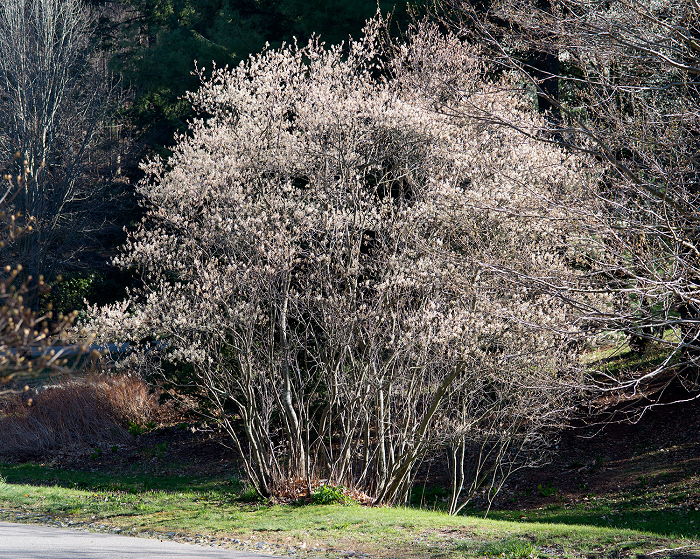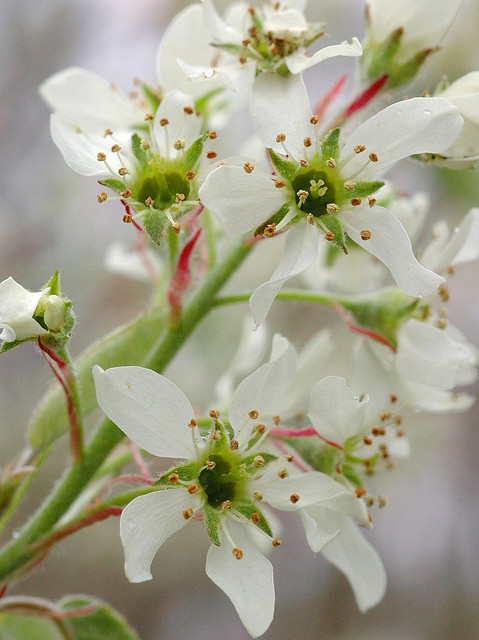Canadian Serviceberry
Amelanchier canadensis (L.) Medik.
Description
Canadian serviceberry, Amelanchier canadensis, is a woody perennial and a member of the rose family (Rosaceae) ³. It has an upright growth pattern. The mature branches of this deciduous variety have smooth gray bark 8. Younger twigs can be purplish-red in color. Its height is variable from 6 to 30 feet ³. Canopy width ranges from around 5 feet to as great as 20 feet or more 8. Smaller A. canadensis can be classified as large shrubs while larger specimens are considered trees. Canadian serviceberry has elliptical leaves, 1 to 2.5 inches long with delicate serration that are richly green from spring through summer 8. In autumn, the leaves transition to flaming orange and red shades before being shed in the winter. Before leaves emerge in spring, A. canadensis produces arcing clusters of delicate 5-petaled flowers with numerous stamens. The blooms can be faintly fragrant and are easily removed by wind and precipitation 6. The edible berries emerge green, turn red and eventually become deep purple at maturity 8.

Fall leaves with serrations of Canadian serviceberry. ³

Smooth bark of Canadian serviceberry. @ B. Hubick*, Maryland Biodiversity Project 5

Flowering Canadian serviceberry. P. Verdonk ²

Flowers of Canadian serviceberry. T. Palmer, MarylandBiodiversity Project 5
Fruits of Canadian serviceberry 11
Distribution
Canadian serviceberry can be found in eastern North America from Canada through states in the southern United States. Range extends from hardiness zones 4 through 7. Habitat characteristics of A. canadensis include understory location, moist to well-drained soil, and a tendency to grow in clustered communities. It should be noted that clay and sandy soils are also usually acceptable. Within Maryland, A. canadensis is predominantly found in the Piedmont, Costal Plain ecoregions 11.

Natural distribution of Canadian serviceberry 12
Wildlife Importance
Found in the forest understory, Canadian serviceberry can be an invaluable resource for a range of wildlife species. Flowers provide a nectar source for native bees and other insects. Leaves and branches offer suitable habitat for caterpillars/butterflies (such as swallowtails, viceroys, red spotted purples.) Birds (including Baltimore Orioles, Cedar Waxwings, American Robins and catbirds) and other species (mammals from chipmunks to deer) rely on the species for habitat and leaves and berries as a food source 6.
Economic Importance
The smaller size of the Canadian serviceberry restricts its usefulness as a timber source. It is still used for smaller woodworking projects such as tool handles and walking sticks 8. By supplying habitat, A. canadensis supports native wildlife and affiliated recreational and tourism resources. The attractive Canadian serviceberry is an excellent variety for retail sale or use in commercial and residential landscaping. (Its vibrant fall oranges and reds make it a particularly good substitute for the invasive burning bush.) The edible berries offer opportunities for the manufacturing of jams, pies, and other confections.
Threats
Amelanchier canadensis is a member of the rose family. As a result it is vulnerable to many of the same pests and pathogens including rust, powdery mildew, mites, scale and leaf miners 8. Fortunately, most threats to Canadian serviceberry tend to be more cosmetic than existential.
Interesting Facts
- The fruits of the Canadian serviceberry are palatable and can be used for making pies, jams and more ³.
- North American indigenous groups including the Chippewa and Cherokee use Canadian serviceberry for culinary as well as medicinal purposes for many generations 8.
- Amelanchier. canadensis has an early, brief, and temperature-dependent blooming period. For this reason, it is considered useful for the study of phenology and climate change. Over a 20-year period, Canadian serviceberry was found to flower 6 days earlier in Washington ,D.C., due to climate change 8. Other studies found a 1.8 to 2.3 day change per increase for every one-degree Fahrenheit increase 10.
- The Canadian serviceberry has several common names: juneberry, shadbush, and shadblow7. The name juneberry was earned because of the fruit ripen in June; the name shadblow is based in the Old English term “blow” (bloom); and shadbush serviceberry comes from flowers that bloom when the American shad were running up rivers 8. This was also the time of the year when the ground was thawed enough to dig graves and hold funeral services; hence the name “serviceberry”.
- It is assisted in obtaining nutrients by an association with mycorrhiza fungi 8.
References
- Lady Bird Johnson Wildflower Center: Amelanchier canadensis)
- Native Plant Trust: Amelanchier canadensis
- Missour Botanical Gardens: Amelanchier canadensis
- Canada serviceberry | The Morton Arboretum
- Maryland Biodiversity Project: Canadian serviceberry
- Serviceberry, Amelanchier spp. – Wisconsin Horticulture
- North Carolina State Extension: Amelanchier canadensis
- USDA Plant Guide: Canadian serviceberry
- University of Maryland Extension: Serviceberry
- National Park Service Species Spotlight: Serviceberry.
- Rotary Botanical Garden: Serviceberry
- Nature’s Restaurant: Serviceberry group
* Imaged used with permission of photographer.
Contributed by M. Gleason and N. Giosa
Towson University Glen Arboretum
